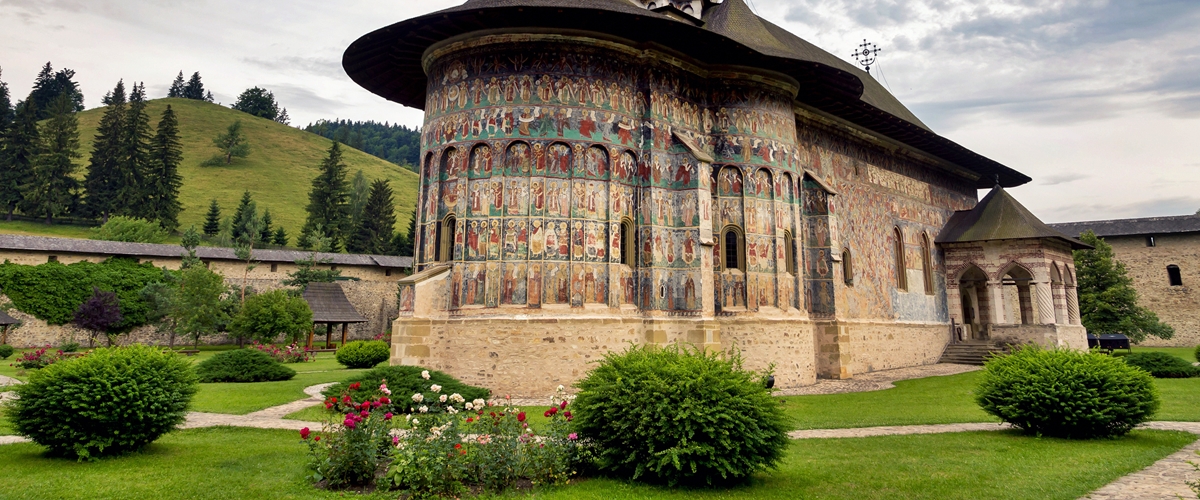Painted Monasteries of Bucovina
Voronet, Arbore, Humor, Moldovita and Sucevita monasteries are representative for Europe for their unicity, being included by UNESCO in the patrimony of the universal art.
In XVIth century, when the pressing of the Turkish armies on Moldavia was at its peak and the Hungarians were trying, on Pope's request, to impose the Catholic religion to the Romanian people, the local artists had discovered the most simple and direct way to transmit to the contemporary people and to the next generation too, the essence of an old tradition. They succeeded in only 20 years to cover the walls of those five churches with a veritable "illustrative Bible".
The most valuable asset of the monasteries in Bucovina, the one for which they are world famous, is their outer wall painting in fresco technique, perceived by Michelangelo, for instance, as 'the most difficult and most daring way of painting'. The painters of the monasteries in Bucovina, most of whom are anonymous, would draw and paint directly on wet lime, upon which they would apply colour layers that would penetrate deep into the plaster. What is coined as almost a miracle is the fact that a layer of colour of only 0,25 cm thick could possibly resist to all climatic, seasonal and human interferences for over 400 years.
The frescoes at Voronet, Arbore, Humor, Moldovita and Sucevita are all governed by a unifying spirit which is expressed on the one hand by the recurrence of artistic styles, means, motifs and scenes, and, on the other hand by the absolute harmony established between man's genius at work and the beautiful natural background against which the monasteries were set.
When you find yourself inside any of the painted monasteries in Bucovina, all you have to do is look around and discover for yourself the patterns adopted by its painters.
Thus the figure of the Holy Virgin, a symbol of the Christian mystery, gleams in the semicupola of the apse. Scenes of the Holy Mass along with sacred themes relating to the most important feasts of the year are painted on the walls all around. The Christ Pantocrator - ruler of all things, placed in the central dome, looks down from 'the rim of heaven' to the earthly world with a stern and yet compassionate eye. Around Him, ranked in hierarchic order, are groups of angels, processions of prophets and apostles, saints and laymen.
The monastery's founders and builders would always be painted on the walls of the narthex; they would kneel down before the Saviour sat on a throne and offer to Him, in all humbleness and veneration, a miniature model of the church.
Once outside, the visitor is dazzled by the perfect chromatic harmony between the light blue background of the monasteries' painted walls and the blue summer sky along the greenshades of lawns, pastures and forests around. These small and colourful churches which soar up skywards like flowers from the ground are a unique artistic form to express man's naive, prodigious and solemn imagination and his irrepressible joy of life.
The value of the frescoes is not only a matter of painting technique. The idea of decorating the outer walls of a church with scenes taken from the Bible is original in itself, since it is a remarkable sample of how people could be educated by means of images during the Middle Ages. The images are a mixture of biblical events with folk tales, legends, and great historical events, like the fall of Constantinople (1453) for instance. The painting would cover the whole wall surface of a church, which is another element that renders the five painted monasteries of Bucovina unique.
In acknowledgement of their singleness, the monasteries in Bucovina are now UNESCO protected cultural sites. In 1975, Bucovina monasteries have been awarded the prestigious 'Pomme d'Or' prize by the International Federation of Writers and Journalists on Tourism.

Built near 1530 in the village of Probota, the Orthodox monastery known as the Probota Monastery is located in Romania.
Almost 500 years have passed since it was built, and between 1996 and 2001, UNESCO carried out substantial restoration, conservation, and archaeological studies there.
Probota Monastery was included to the World Cultural and Natural Heritage List (UNESCO) in 1993 for both its architectural originality and its significance as an important example of a structural style characteristic of an era in history.
The building's monastic cells were destroyed by fire at the start of the 20th century. Currently, what is left of these structures, which are being repaired, are several ruins and some cellars.
Probota Monastery was an important centre of Romanian culture in the Middle Ages. The monastery appears to have been finished in 1530 and painted in 1532. The additional projects appear to have been completed a few years after the monastery components, according to recent archaeological findings.
The Probota monastery's museum, officially opened in October 2009, features cult artefacts from the 15th to the 18th centuries including vestments, antiquated church literature, icons, and more.




.png)



